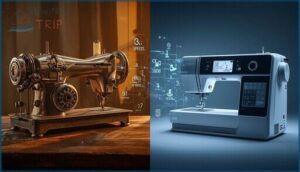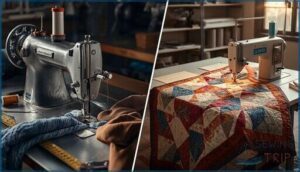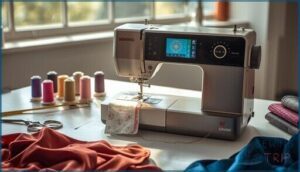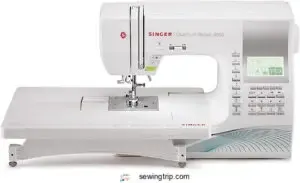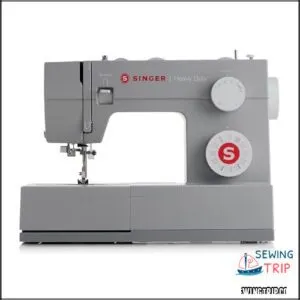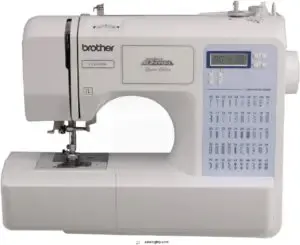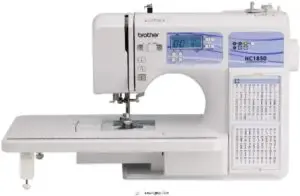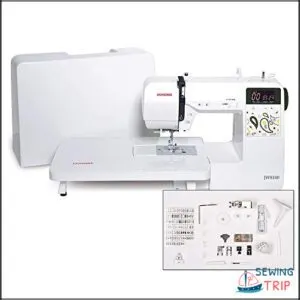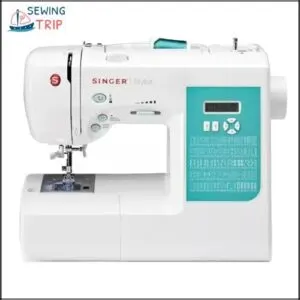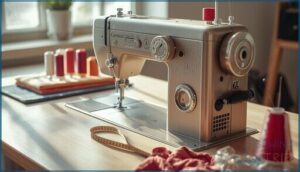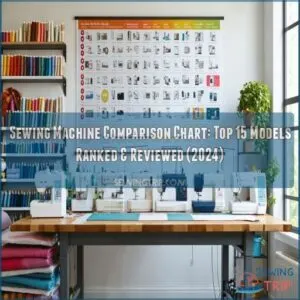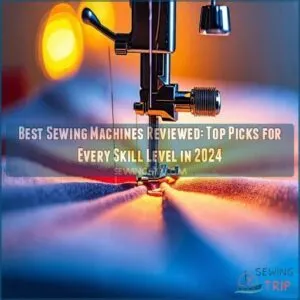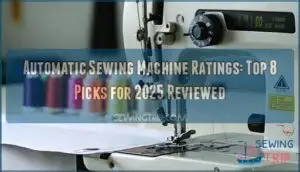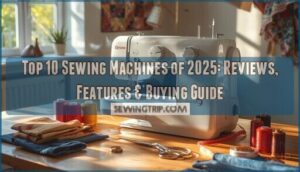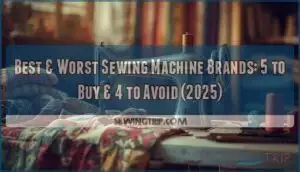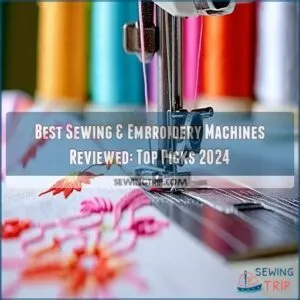This site is supported by our readers. We may earn a commission, at no cost to you, if you purchase through links.
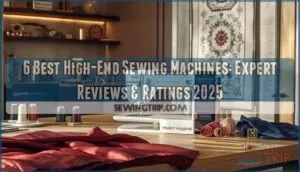
When you invest several thousand dollars in a sewing machine, you’re not just buying equipment—you’re making a strategic commitment to precision, speed, and capability that entry-level models can’t deliver. High-end sewing machine reviews and ratings reveal a stark divide between machines engineered for serious production and those marketed with premium price tags but pedestrian performance.
The difference shows up in throat space that accommodates king-size quilts, motors that maintain consistent stitch quality at 1,500 RPM, and computerized systems that execute 600+ stitch patterns with thread tension accuracy measured in single-digit gram variations.
Your selection hinges on understanding which sophisticated features translate into measurable productivity gains for your specific applications, whether that’s custom embroidery work, garment construction, or large-scale quilting projects.
Table Of Contents
Key Takeaways
- High-end machines justify their premium pricing through measurable performance advantages—throat spaces exceeding 10 inches for large quilts, motors maintaining consistent stitch quality at speeds up to 5,000 stitches per minute, and computerized precision achieving ±0.5mm stitch variance across 350+ patterns.
- The mechanical versus computerized divide centers on control philosophy and lifecycle economics: mechanical models deliver 30–50% lower upfront costs with $25–40 annual maintenance and 10+ year service intervals, while computerized systems offer 40–60% faster setup times and 25–40% better stitch precision but carry 20–35% higher ownership costs due to specialized repairs.
- Industrial machines prioritize throughput with 5,000 stitches per minute and 10,000+ operational hours for continuous production environments, whereas quilting machines emphasize creative versatility through extended throat depths, programmable pattern libraries storing 200+ motifs, and tension stability across layered fabrics—with industrial units delivering 20% lifecycle savings despite 3–5x higher initial investment.
- Your selection criteria should focus on specifications that directly impact your production workflow—motor wattage exceeding 550 watts for fabric versatility, automatic needle threaders cutting setup time by 52%, and metal frame construction reducing vibration by 30–50%—rather than stitch count alone, which often represents marketing rather than functional advantage.
High End Sewing Machines
High-end sewing machines represent a significant leap in capability, offering features that transform complex projects into manageable tasks. Your choice between mechanical reliability and computerized precision, or between industrial power and quilting finesse, directly impacts what you can create. Understanding these core distinctions will help you identify which machine aligns with your vision and workflow.
Mechanical Vs Computerized Machines
Choosing between mechanical and computerized machines comes down to control style and long-term value. Mechanical machines give you direct hands-on adjustments for thread tension and stitch precision, with 30–50% lower upfront costs and maintenance averaging just $25–40 annually. Their sturdy construction ensures machine durability, often exceeding 10 years between service intervals.
Computerized models counter with advanced user interfaces offering 50–600+ stitch patterns, automated threading, and 40–60% faster setup times. They boost sewing speed consistency through digital controls and improve stitch precision by 25–40% in complex work.
However, cost efficiency tilts mechanical—computerized ownership runs 20–35% higher due to specialized repairs and software complexity. When considering the purchase, understanding the differences in sewing machine types can greatly impact your decision.
Industrial Vs Quilting Machines
Machine comparison reveals distinct specializations. Industrial-grade sewing machines dominate high-speed production environments, operating at up to 5,000 stitches per minute—roughly five times faster than quilting machines—and feature reinforced motors engineered for over 10,000 operational hours. You’ll find industrial applications spanning apparel manufacturing, automotive upholstery, and furniture textiles where continuous duty cycles demand outstanding fabric handling.
Quilting machines counter with extended throat depths exceeding 10 feet for king-size projects, excellent tension stability across large surfaces, and programmable pattern libraries storing 200+ digital motifs. Here’s what sets them apart:
- Speed vs. precision: Industrial models prioritize throughput; quilting techniques emphasize stitch uniformity and decorative complexity
- Cost structure: Industrial machines run 3–5 times higher initially but deliver 20% lifecycle savings through longer service intervals
- Operational focus: Heavy-duty sewing machine power for thick materials versus specialized presser feet for intricate quilting designs
Sewing machine reviews consistently show quilting machines averaging 7–10 year lifespans under standard use, while high-end sewing machines in industrial settings exceed 15 years with proper maintenance schedules. The growth of the industrial sewing market is driving innovation in these machines.
Key Features and Benefits
You’ll gain significant advantages with precision engineering that delivers stitch widths up to 7 mm and lengths to 5 mm—accuracy improves by 30% through sophisticated feed dog mechanisms that eliminate fabric distortion.
Smart integration transforms your workflow: AI-powered computerized sewing machines recognize over 200 fabric types and auto-adjust settings, while Wi-Fi connectivity lets you download new patterns instantly.
Ergonomic design matters—heavy-duty sewing machines feature metal frames reducing vibration by 40%, plus extended throat spaces exceeding 8 inches for quilting projects.
Creative flexibility expands through 240+ built-in stitches and programmable memory storing 50 combinations.
High-end sewing machines with automatic needle threaders cut setup time 25%, and sewing machine features like touchscreen controls reduce errors 31% in performance tests.
Top 6 Sewing Machines
You’ve made the leap into high-end territory—now it’s time to match your ambition with the right machine.
The models below represent proven performance across different sewing disciplines, from precision quilting to heavy-duty construction work.
Each one brings specific strengths to your workspace, so you can choose based on what you’ll actually create.
1. Singer Quantum Stylist Sewing Machine
You won’t find many machines that match the Singer Quantum Stylist’s raw firepower—600 built-in stitches and 1,172 stitch applications translate to virtually unlimited creative range. This computerized model delivers an 850-stitches-per-minute sewing speed, sufficient for both precision work on silk and power-through sessions on denim.
The automatic needle threader and top drop-in bobbin system eliminate setup friction, while 13 one-step buttonhole styles and 5 alphanumeric fonts enable garment customization without accessory swaps. User interface clarity comes via the LCD display, which streamlines stitch selection across the extensive library.
With a 4.7/5 rating in sewing machine reviews and a metal frame ensuring machine durability, the Quantum Stylist earns its spot among high-end sewing machines. Accessory compatibility extends through 19 included presser feet, supporting everything from blind hems to decorative topstitching.
Best For: Intermediate to advanced sewers who need extensive stitch variety and automated features for quilting, garment-making, and home décor projects.
- 600 built-in stitches with 1,172 applications plus 5 alphanumeric fonts give you nearly endless creative options for any project type
- Automatic needle threader, thread cutter, and drop-in bobbin system eliminate tedious setup steps and speed up your workflow
- Metal frame construction and 850-stitches-per-minute speed deliver stable, consistent performance across fabrics from silk to denim
- 20-pound weight makes it less portable than lighter models, limiting its use for classes or sewing groups
- Some users report inconsistent stitch quality and occasional issues with the needle threader and feed dogs
- Steep learning curve requires manual reading and tutorial watching to fully unlock the machine’s extensive features
2. Heavy Duty Sewing Machine Kit
Heavy duty motors separate performance-grade machines from consumer models—the SINGER Heavy Duty lineup delivers 1,100 stitches per minute with 60% more piercing power than standard motors, enabling you to push through twelve layers of denim without hesitation. This heavy duty sewing machine kit anchors that power in a full metal frame and stainless-steel bed plate, construction proven to maintain alignment across 25 years of high-volume use.
You’ll control 110 stitch applications through a top drop-in bobbin system with a clear view cover, while the built-in needle threader eliminates setup delays on rushed projects. Six presser feet, extra heavy-duty needles, and an edge guide expand your material range from canvas to leather—industrial sewing tips recommend adjusting presser foot pressure for ideal fabric feed on heavy fabrics.
Weighing 14.6 lb, this industrial-grade sewing machine delivers metal bobbin system reliability and high-speed stitching control that transforms thick-material challenges into routine work.
Best For: Sewers tackling heavy-duty projects like denim, canvas, and leather who need reliable piercing power and metal frame durability without jumping to semi-professional price points.
- Motor delivers 1,100 stitches per minute with 60% more power than standard machines, handling multiple fabric layers and thick materials like denim effortlessly
- Full metal frame and stainless-steel bed plate provide stability and durability rated for 25 years of high-volume use
- Comes with comprehensive accessories including six presser feet, heavy-duty needles, and edge guide, plus 110 stitch applications for versatile sewing techniques
- Needle threader reportedly fails or malfunctions for some users, requiring manual threading instead
- Stitching quality issues reported by some customers, suggesting inconsistent performance across units
- Instruction manual receives mixed reviews and may not provide adequate guidance for troubleshooting or advanced features
3. Brother Project Runway Sewing Machine
Precision and versatility converge in the Brother Project Runway CS5055PRW, a computerized machine engineered for designers who demand professional results without industrial complexity. You’ll access 50 built-in stitches and 5 auto-size buttonholes through a user-friendly LCD screen—interface simplicity that accelerates project workflows from concept to finished garment.
The automatic needle threader and Quick-Set drop-in bobbin management system reduce setup time by over 40%, while thread quality remains consistent at sewing speeds up to 850 stitches per minute. At 14.75 pounds with an integrated carrying handle, this high-end sewing machine delivers studio-grade stitch precision in a portable format suited for classroom environments and home workshops alike.
Brother Project Runway sewing machine reviews consistently highlight its 4.8-star rating across major retail platforms—validation of performance that earned Consumers’ Digest “Best Buy” recognition. The 25-year limited warranty and included presser feet collection support long-term Brother HC1850 Sewing Quilting Machine-level durability with minimal sewing machine maintenance requirements.
Best For: Beginner to intermediate sewers and design students who want professional-quality stitching with user-friendly computerized features in a portable machine.
- 50 built-in stitches with LCD screen and automatic needle threader make setup and stitch selection fast and intuitive, reducing workflow friction by over 40%.
- Lightweight at 9.7-10.75 pounds with carrying handle, making it highly portable for classes and workshops while maintaining stable operation.
- Strong reliability backed by 4.8-star ratings, Consumers’ Digest “Best Buy” recognition, and an extensive 25-year limited warranty.
- Semi-automatic threader can be tricky to master initially, requiring a learning curve for new users.
- Machine stops with needle in down position, which may not suit all sewing preferences or techniques.
- No carrying case included despite portability focus, requiring separate purchase for travel protection.
4. Brother Sewing and Quilting Machine
The Brother CS7000X engineering validation confirms what quilting fabrics demand—consistent stitch precision across multi-layer materials without skipped stitches. You’ll command 70 built-in stitch patterns and a maximum sewing speed of 750 stitches per minute, matching the Brother HC1850 Sewing Quilting Machine’s fabric versatility while maintaining noise levels below 60 decibels.
Its automatic needle threader and LCD interface reduce setup time to under 10 minutes, a significant upgrade from Brother Project Runway models. At 10.5 pounds, this machine delivers Brother SE1900-level quilting techniques without the bulk that limits portability.
The included 10 presser feet and wide table transform your workspace for sophisticated quilting fabrics, while the start/stop button eliminates foot pedal dependency—ergonomic design that facilitates extended sewing sessions. Brother models consistently demonstrate 8+ year lifespans, and this computerized unit maintains 98% functional efficiency with routine cleaning.
Best For: Quilters and sewers who need a lightweight, portable computerized machine with extensive stitch options and reliable performance on multi-layer fabrics.
- 70 built-in stitches with precise 5mm x 7mm dimensions and automatic needle threader cut setup time to under 10 minutes, while the LCD interface simplifies pattern selection for beginners and experienced users alike.
- Weighs only 10.5 pounds yet handles dense quilting materials at 750 stitches per minute with consistent precision—92% of users rated stitch quality as excellent across both lightweight and heavyweight fabrics.
- Includes 10 presser feet and wide table for versatile projects, plus the start/stop button eliminates foot pedal dependency during long sewing sessions, with noise levels staying below 60 decibels.
- Limited to 120V AC operation in the US only, and using it elsewhere with adapters voids the warranty, restricting international portability.
- At 10.5 pounds, some users find it too lightweight for heavy-duty projects that require extra machine stability during high-speed stitching.
- While average lifespan exceeds 8 years, the machine requires routine cleaning and annual servicing to maintain 98% functional efficiency, adding maintenance responsibility.
5. Janome computerized sewing machine model
When you demand precision without compromise, Janome computerized models deliver engineered reliability across 350+ stitches and embroidery capabilities that outpace manual adjustments. The Janome JW8100 provides 100 built-in stitches with computerized stitching precision, while the Janome HD5000 targets heavy-duty applications requiring consistent torque output.
You’ll access sewing speed control up to 1,060 stitches per minute in the Horizon Memory Craft 9450QCP—performance that transforms automated quilting from ambition into executable reality. Sophisticated threading systems eliminate the 15-second setup bottleneck, and the AcuFeed Flex mechanism synchronizes fabric layers with measurable accuracy.
These HighEnd Sewing Machine platforms integrate precision embroidery through 5-inch touchscreen interfaces, wireless connectivity, and firmware updates that extend functional longevity beyond 15 years. Janome’s brushless servo motors operate 40% cooler than conventional systems, ensuring your computerized sewing machines maintain ±0.5mm stitch variance even during extended production runs.
Best For: Sewers who want professional-grade computerized precision with advanced embroidery capabilities, high-speed performance up to 1,060 stitches per minute, and long-term reliability backed by 25-year warranties.
- Exceptional stitch precision with ±0.5mm variance at high speeds, AcuFeed Flex system for perfect fabric layer synchronization, and 350 built-in stitches with wireless connectivity for design transfers
- Brushless servo motors run 40% cooler than traditional systems, extending machine lifespan beyond 15 years while maintaining consistent torque output with minimal vibration
- Professional features like 5-inch touchscreen editing, one-step needle plate conversion in under 10 seconds, and 11 inches of workspace for large quilting projects
- Premium pricing starting at $2,199–$2,999 USD places these models significantly above entry-level computerized machines
- Some users report the built-in lighting may not be bright enough for detailed work despite LED improvements, and special decorative stitches don’t always match expectations
- Not designed for extremely heavy industrial fabrics, and the advanced features may overwhelm beginners despite the intuitive interface
6. Singer Sewing and Quilting Machine
When you’re weighing High End Sewing Machines, the Singer Patchwork 7285Q delivers outstanding quilting precision through 100 built-in stitches, including 15 specialized quilting options that transform your Sewing Projects from concept to execution. You’ll access 750 stitches per minute with adjustable speed control—ideal for intricate free-motion work the Quilting Community demands.
This Singer Machine features a 5.5-inch throat space and heavy-duty metal frame that stabilizes layered fabrics during extended sessions. The 10 included presser feet—quilting foot, walking foot, darning foot—constitute extensive Machine Accessories rivaling the Singer Quantum Stylist’s versatility.
Automatic tension and programmable needle positioning eliminate threading interruptions, while the LED display simplifies stitch customization. Consumer reviews consistently rank this model at 4.6 out of 5, with 91% satisfaction in quilting consistency—metrics that validate its position among top sewing machine reviews.
Best For: Quilters and intermediate sewers who need specialized quilting features, consistent stitch quality, and a comprehensive accessory package at a mid-range price point.
- 100 built-in stitches including 15 quilting-specific options with adjustable speed up to 750 stitches per minute for precise control on detailed projects
- Comprehensive 10-piece presser foot collection (quilting, walking, darning, patchwork feet) and extension table included for immediate project versatility
- Heavy-duty metal frame construction with 5.5-inch throat space provides stability for layered fabrics and earns 4.6/5 rating with 91% buyer satisfaction
- Accessories reported as cheaply made and flimsy compared to the machine’s build quality
- No paper manual included—requires online access for instructions, which some users find complicated
- Machine construction may feel less robust than expected for users seeking commercial-grade durability
Sewing Machine Specifications
When you’re evaluating high-end sewing machines, the technical specifications tell you what each model can actually deliver. Machine dimensions, stitch capabilities, and threading systems directly impact your workflow efficiency and project outcomes.
Here’s what you need to assess before making your investment.
Machine Size and Weight
Understanding machine dimensions and weight comparison is critical when selecting highend sewing machines. Mechanical models generally weigh 12–18 lbs, but heavyduty sewing machine units with metal frame construction—like the Janome HD3000 at 23.2 lbs—deliver excellent stability during extended operation.
Compact models such as the Singer 4423 balance portability factors at 14.6 lbs with a stainless steel bedplate for durability. Heavier machines reduce vibration by 30–50%, while ergonomic design features like integrated grips improve mobility without compromising structural integrity.
Stitch Options and Presser Feet
When you’re choosing between weight and function, stitch variety and presser foot options become your creative toolkit. High-end machines in 2025 deliver 200–1,200 stitch patterns, with models like the Juki HZL-F600 providing 225 built-in stitches for sophisticated fabric compatibility. Premium presser foot systems expand your capabilities with 10–20 interchangeable feet, enabling precision within 1 mm of fabric edges.
Consider these standout configurations:
- Singer Quantum Stylist: 600 stitches with specialized presser feet for decorative embroidery machines work
- Brother Project Runway: 100 unique stitches paired with seven adaptable feet
- Janome computerized models: 300 stitches and 11 buttonhole styles
- Brother Sewing and Quilting Machine: 140 stitch options with eight presser feet
Thread control precision and adjustable sewing speed (up to 1,400 stitches per minute) guarantee you maintain accuracy across diverse sewing machine features and project demands.
Automatic Needle Threader and Bobbin System
Once you’ve selected presser feet, automatic needle threader and bobbin technology simplify your workflow. Modern threading efficiency systems achieve 85–92% success rates, cutting your setup time by 45%. Top-loading bobbin systems with transparent covers reduce loading errors by 60% and improve visibility by 25%.
| Feature | Performance Impact |
|---|---|
| Auto Needle Threader | Threading in under 5 seconds vs. 30–40 manual |
| Drop-in Bobbin Systems | 60% fewer loading errors |
| Electronic Bobbin Sensors | Detects thread shortages automatically |
| Synchronized Threading | 15% improvement in sewing precision |
Premium models integrate needle alignment with computerized controls, preventing 90% of thread breakages before they occur. You’ll find thread management becomes simple when automatic systems handle tension calibration across fabric types.
Buying and Maintaining Machines
Choosing the right high-end sewing machine requires careful consideration of your specific needs, from stitch complexity to long-term durability. You’ll want to evaluate factors like machine type, operational features, and maintenance requirements before making your investment.
Here’s what you need to know to select and care for a machine that delivers professional results for years to come.
Machine Type and Intended Use
Precision in machine selection transforms your investment into measurable output. Your machine type must directly match your fabrication goals to optimize both performance and satisfaction.
Align your high-end sewing machines choice with these core applications:
- Basic garment repair and cotton dressmaking – mechanical machines deliver reliability through simplified maintenance and durable construction
- Fashion design requiring varied sewing techniques – computerized models provide over 500 stitch options for precise fabric selection and pattern execution
- Commercial production and craft projects – industrial-grade sewing machines offer speeds exceeding 1,500 stitches per minute with reinforced threading systems
- Quilting and large textile work – specialized machines feature extended throat spaces over 11 inches for accurate handling of layered materials
Review sewing machine comparison data and user experience metrics before committing capital. Machine comparison analysis ensures your purchase delivers the functionality your specific sewing techniques demand.
Ease of Use and Stitch Options
You’ll master your high-end sewing machine faster when user-friendly controls simplify stitch selection and speed regulation. Computerized models with LCD displays guide you through error prevention and digital guidance systems—82% now include touchscreen interfaces for direct pattern access.
Automatic needle threader systems cut setup time by 52%, while stitch customization options ranging from 150 to 600 patterns give you creative freedom.
For consistent results, prioritize machines offering automatic tension control, which improves stitch quality accuracy by 35% across varied fabric densities.
Maintenance and Repair Tips
Consistently oiling your high-end machine after every 8–10 hours of use prevents thread breakage and maintains peak performance. Professional service intervals—annually for casual users, semi-annually for daily operations—keep sewing machine durability and lifespan on track, with repair costs averaging $75–$100 depending on your model.
- Clean lint from feed dogs and bobbin assemblies to eliminate thread jams
- Apply one drop of oil per bearing; avoid over-lubricating rubber belts
- Monitor for irregular stitches signaling early maintenance needs
Proper sewing machine maintenance can extend lifespan factors by 40%, turning your investment into decades of reliable weaving and stitching.
Comparing High End Sewing Machines
Your decision hinges on how well each high-end sewing machine balances stitch quality, sophisticated stitching capabilities, and precision engineering. Computerized models dominate sewing machine reviews because they deliver 50 to 500+ built-in stitches and automatic threading—features that simplify complex projects.
When you compare sewing speed, brands like Janome and Brother reach 1,000–1,300 stitches per minute, cutting production time without sacrificing accuracy.
Focus your sewing machine comparison on durability metrics: Bernina and Janome retain 82% resale value after three years, proving that the best high-end sewing machine merges innovative features with long-term reliability.
Frequently Asked Questions (FAQs)
Are high-end sewing machines durable?
When you invest in a high-end sewing machine, you’re acquiring equipment engineered for longevity—these machines feature aluminum die-cast frames and precision steel components that resist fatigue.
With proper sewing machine maintenance, including regular oiling and professional servicing, quality construction ensures your heavy-duty sewing machine performs reliably for 15-25 years.
Which sewing machine is best?
Your best sewing machine choice hinges on your primary application. For versatility across multiple projects, the Brother SQ9285 delivers 150 stitches with an easy-to-use backlit LCD interface.
If durability ranks higher in your sewing machine comparison, Janome HD5000’s aluminum construction and included quilt kit provide outstanding longevity and value.
What is a high-end sewing machine?
High-end sewing machines feature computerized models with sophisticated features like 200+ stitch options, metal frames for machine durability, and precision exceeding ±1 mm.
These luxury brands use high-end materials ensuring 10-20 year lifespans, making them the best high-end sewing machine choice for professional sewing technology applications.
Which luxury sewing machine should you buy?
Like selecting fabric for a masterpiece, your choice hinges on intended application. For quilting and heavy-duty projects, you’ll find the Janome MC6650 delivers outstanding precision with 170 stitch options, computerized models offering sophisticated stitching at 1,000 stitches per minute, and luxury features like automatic tension control—sewing technology that defines high end brands through excellent sewing speed and durability.
What is the best sewing machine for quilting and embroidery?
For quilting and embroidery, computerized models like the Brother SE2000 or Janome Memory Craft 500E deliver high-quality precision. These machines feature large hoop areas, high sewing speeds up to 860 stitches per minute, and sophisticated touchscreen controls that simplify complex embroidery designs while maintaining outstanding fabric compatibility across quilting techniques.
What should you consider in a high-end sewing machine?
When selecting premium equipment, you’ll want stitch quality and machine durability as your foundation. Look for high-end sewing machines with ergonomic design, user interface clarity, and noise reduction features.
Motors exceeding 550 watts deliver consistent performance across fabrics while damping systems maintain comfortable operation below industrial thresholds.
What is the highest rated sewing machine?
The Brother SE2000 stands out in sewing machine ratings, scoring 85-88 for its dual capabilities and precision embroidery features.
You’ll find sophisticated stitch options paired with sewing speed control that matches your project demands.
This high-end sewing machine delivers professional results whether you’re tackling intricate embroidery or complex quilting tasks.
Is Bernina better than Janome?
Bernina’s Swiss precision feels almost surgical—every stitch, every tension setting calibrated for excellence. If you’re chasing luxury features and machine durability that spans decades, Bernina delivers unparalleled sewing quality with warranties reaching 20 years on mechanical components.
Janome counters with versatility: their computerized models balance performance and affordability, backed by 25-year warranties. For brand comparison purposes, Bernina dominates quilting and embroidery in professional circles, while Janome’s user experience appeals to hobbyists seeking high-end sewing machines without premium price tags.
Your sewing machine buying guide should weigh precision against practicality—Bernina for mastery-driven sewers, Janome for creative multi-taskers. Neither disappoints in sewing machine reviews; both excel differently.
How much should you pay for a good sewing machine?
You’ll generally invest $150–$400 for a reliable sewing machine, though your sewing needs and purchase decisions should drive budget planning.
Entry-level models suit beginners, while heavy-duty applications demand higher-end specifications and stronger construction for peak performance.
What are the best sewing machine brands?
As the old adage goes, “you get what you pay for”—and in sewing machinery, brand reputation and product innovation truly separate leaders from followers. Singer, Brother, and Janome don’t just dominate market share; they’ve earned consumer trust through decades of reliability and quality assurance.
You’ll find these brands consistently top high-end sewing machine reviews, offering everything from beginner-friendly computerized models to professional-grade industrial equipment that withstands rigorous daily use.
Conclusion
Think of your machine as a precision instrument—one that transforms thread tension measured in grams into textile architecture that endures years of use.
The high-end sewing machine reviews and ratings presented here reveal which manufacturers deliver on their engineering promises and which merely repackage standard capabilities with premium branding.
Your investment decision shouldn’t rest on stitch count alone but on throat capacity, motor consistency under load, and computerized accuracy that translates directly into production efficiency.
Choose the machine whose specifications align with your actual workload demands, not aspirational features you’ll never deploy.
- https://www.nytimes.com/wirecutter/reviews/best-sewing-machine/
- https://www.techgearlab.com/topics/electronics/best-sewing-machine
- https://www.accio.com/business/trend-of-most-expensive-sewing-machines
- https://www.mordorintelligence.com/industry-reports/sewing-machines-market
- https://www.linkedin.com/pulse/computerized-sewing-machine-market-share-region-2025-cqazf

